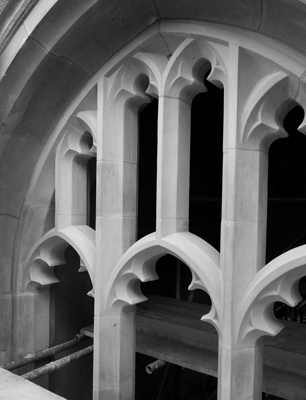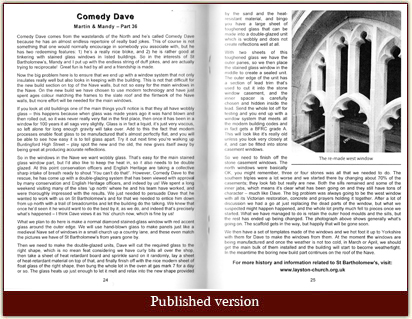Martin & Mandy
Comedy Dave comes from the wastelands of the North and he's called Comedy Dave because he has an almost endless repertoire of really bad jokes. This of course is not something that one would normally encourage in somebody you associate with, but he has two redeeming features: 1) he's a really nice bloke and 2) he is rather good at tinkering with stain glass windows in listed buildings. So in the interests of St Bartholomew's Mandy and I put up with the endless string of duff jokes, and are actually trying to reciprocate! Great fun is had by all and a friendship is made.
Now the big problem here is to ensure that we end up with a window system that not only insulates really well but also looks in keeping with the building. This is not that difficult for the new build section on top of the Nave walls, but not so easy for the main windows in the Nave. On the new build we have chosen to use modern technology and have just spent ages colour matching the frames to the slate roof and the flint work of the Nave walls, but more effort will be needed for the main windows.
If you look at old buildings one of the main things they all have is wobbly glass - this happens because when glass was made years ago it was hand blown and then rolled out, so it was never really very flat in the first place, then once it has been in a window for 100 years it all sags very slightly. Glass is in fact a liquid, it's just very viscous, so left alone for long enough gravity will take over. Add to this the fact that modern processes enable float glass to be manufactured that's almost perfectly flat, and you will be able to see how easy it is to tell glass apart. Try it out next time you're walking up Buntingford High Street - play spot the new and the old, the new gives itself away by being great at producing accurate reflections.
 So in the windows in the Nave we want wobbly glass, that's easy for the main stained glass window part, but I'd also like to keep the heat in, so it also needs to be double glazed. At this point Conservation officers and English Heritage are taking a collective sharp intake of breath ready to shout 'You can't do that!'. However, Comedy Dave to the rescue, he has come up with a double glazing system that has been viewed with approval by many Conservation and English Heritage officers, and indeed by us! We spent a long weekend visiting many of the sites 'up north' where he and his team have worked, and were thoroughly impressed with the results. We just needed to persuade Dave that he wanted to work with us on St Bartholomew's and for that we needed to entice him down from up north with a trail of breadcrumbs and let the building do the talking. We knew that once he'd seen it he would want to do the best by it, as we do, and indeed that's precisely what's happened - I think Dave views it as 'his' church now - which is fine by us!
So in the windows in the Nave we want wobbly glass, that's easy for the main stained glass window part, but I'd also like to keep the heat in, so it also needs to be double glazed. At this point Conservation officers and English Heritage are taking a collective sharp intake of breath ready to shout 'You can't do that!'. However, Comedy Dave to the rescue, he has come up with a double glazing system that has been viewed with approval by many Conservation and English Heritage officers, and indeed by us! We spent a long weekend visiting many of the sites 'up north' where he and his team have worked, and were thoroughly impressed with the results. We just needed to persuade Dave that he wanted to work with us on St Bartholomew's and for that we needed to entice him down from up north with a trail of breadcrumbs and let the building do the talking. We knew that once he'd seen it he would want to do the best by it, as we do, and indeed that's precisely what's happened - I think Dave views it as 'his' church now - which is fine by us!
What we plan to do here is make a normal diamond stained glass window with red accent glass around the outer edge. We will use hand blown glass to make panels just like a medieval Nave set of windows in a small church up a country lane, and these even match the pictures we have of St Bartholomew's from years gone by.
Then we need to make the double glazed units, Dave will cut the required glass to the right shape, which is no mean feat considering we have curly bits all over the shop, then take a sheet of heat retardant board and do something secret to in involving a ferret and some odd Northern customs then bung the whole lot in the oven at gas mark 7 for a day or so. The glass heats up just enough to let it melt and relax into the new shape provided by the work the ferret has completed along with some heat resistant material and bingo you have a large sheet of toughened glass that can be made into a double glazed unit which is wobbly and does not create reflections well at all.
With two sheets of this toughened glass we have the outer panes so we place the stained glass window in the middle to create a sealed unit. The outer edge of the unit has a section lead trim that's used to cut it into the stone window casement and the inner spacer is carefully chosen and hidden inside the lead. Send the whole lot of for testing and you end up with a window system that meets all the modern building codes and in fact gets an BFRC grade A. This will look like it's really old unless you look very closely at it, and can be fitted into stone casement windows.
So we need to finish off the stone casement windows. You might remember the North windows were basically OK, three or four stones was all that we needed to do. The southern triples were a lot worse and we started there by changing about 70% of the casements, they look fab but really are new. However both the sills remained and some of the inner jabs which means it's clear what has been going on and they still have tonnes of character - much like Dave. The big problem was always going to be the west window with all its Victorian restoration, concrete and prayers holding it together. After a lot of pondering and discussion we had a go at just replacing the dead parts of the window, but what we suspected might happen happened, and the whole lot pretty much fell to pieces once we started. What we have managed to do is retain the outer hood moulds and the sills on the window but the rest has ended up being changed. The picture here shows generally what's going on but the scaffold really gets in the way, happily that will be gone soon.
they look fab but really are new. However both the sills remained and some of the inner jabs which means it's clear what has been going on and they still have tonnes of character - much like Dave. The big problem was always going to be the west window with all its Victorian restoration, concrete and prayers holding it together. After a lot of pondering and discussion we had a go at just replacing the dead parts of the window, but what we suspected might happen happened, and the whole lot pretty much fell to pieces once we started. What we have managed to do is retain the outer hood moulds and the sills on the window but the rest has ended up being changed. The picture here shows generally what's going on but the scaffold really gets in the way, happily that will be gone soon.
We then have a set of templates made of the windows and we hot foot it up to Yorkshire with them for Dave to make the windows from them. At the moment the windows are being manufactured and once the weather is not too cold in March or April we should get the main bulk of them installed and the building will start to become weather tight. In the mean time the boring new build part continues on the roof of the Nave.
 |
|
 |

